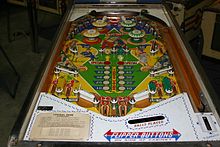Gottlieb
|
Gottlieb logo from 1980.
|
|

Central Park, a 1966 pinball machine by Gottlieb.
|
|
| Gottlieb | |
| Industry | Pinball and Arcade videogames |
| Successor | Gottlieb Development LLC |
| Founded | Chicago, Illinois (1927) |
| Founder | David Gottlieb |
| Defunct | 1996 |
Gottlieb (formerly D. Gottlieb & Co.) was an arcade game corporation based in Chicago, Illinois. The main office and plant was located at 1140-50 N. Kostner Avenue until the early 1970s when a new modern plant and office was located at 165 W. Lake Street in Northlake, IL. A subassembly plant was located in Fargo, ND. The company was established by David Gottlieb in 1927, initially producing pinball machines while later expanding into various other games including pitch-and-bats, bowling games, and eventually video arcade games (notably Reactor and Q*bert and, leading to the demise of Mylstar; M*A*C*H*3).
Like other manufacturers, Gottlieb first made mechanical pinball machines, including the first successful coin-operated pinball machine Baffle Ball in 1930.Electromechanical machines were produced starting in 1935. The 1947 development of player-actuated, solenoid-driven 2-inch bats called "flippers" revolutionized the industry. Players now had the ability to shoot the ball back up the playfield and get more points. The flippers first appeared on a Gottlieb game called "Humpty Dumpty", designed by Harry Mabs. By this time, the games also became noted for their artwork by Roy Parker.
In the late 1950s the company made more widespread use of digital score reels, making multiple player games more practical as most scoring was expressed by cluttered series of lights in the back box. The score reels eventually appeared on single-player games, now known as "wedgeheads" because of their distinctive tapering back box shape. By the 1970s the artwork on Gottlieb games was almost always by Gordon Morison, and the company had begun designing their games with longer 3-inch flippers, now the industry standard.
The company made the move into solid state machines starting in the late 1970s. The first few of these were remakes of electromechanical machines such as "Joker Poker" and "Charlie's Angels". By that time, multiple player machines were more the mode and wedgeheads were no longer being produced. The last wedgehead was "T.K.O." (1979) and the last single player machine was "Asteroid Annie and The Aliens" (1980)
...
Wikipedia
